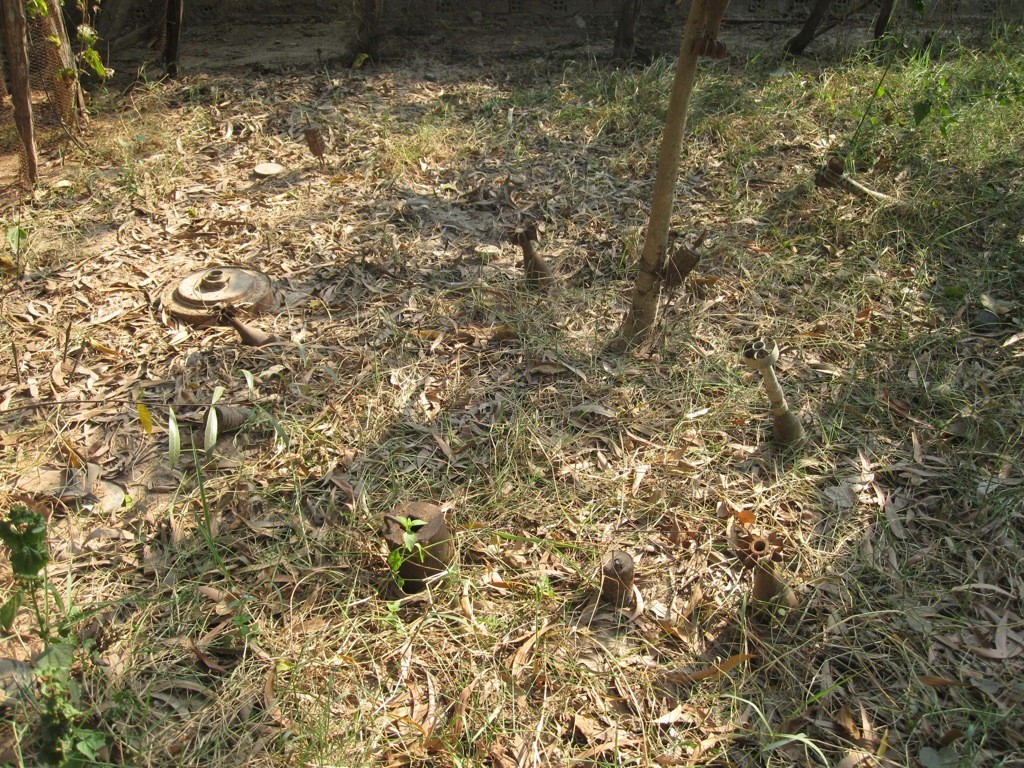Dinosaur Bones
So today we got to hold real dinosaur bones! And get a sneak preview of some very large, very impressive, and as yet unidentified skeletal pieces from a dig a few miles away last month, still in the red rock that holds them. (No photos, sadly, for reasons of academic privacy.)
It’s a rather eerie feeling, encountering something so old, so close. A surprisingly delicate chunk of the hipbone of an as yet unidentified carnivore, it looked as though the creature could have been alive within my lifetime, yet weighed cold, dead and heavy in my hands.
It would be fair to say that we approached the Dinosaur Museum in Savannakhet, Laos, with low expectations, after a slightly disappointing experience in Cambodia with the Landmine Museum outside Siem Reap.
Z, who has been obsessing over the difference between plastic and metal landmines since talking to Tree about his sad life history in Bokor National Park, was very much looking forward to the Landmine Museum.
I had read, and read to him, that it had a garden in which you can hunt for deactivated landmines. So he had envisaged whizzing around with metal detectors, bleeps on flashing screens, perhaps some sound-effects, or even a score-counter. You know. The kind of stuff you get at a museum in the UK.
In fact, the garden is a fenced-off stretch of scrubby turf, with saplings, studded with more-or-less camouflaged devices, from tripwires to UXOs, at (terrifyingly) the approximate density of a typical minefield.Had we come on it by chance, with no expectations, a game of spot the landmine would have been the most delightful thing. As it was, it felt like something of an anticlimax.
Without such expectations, the Landmine Museum is a lovely provincial museum. The founder, Aki Ra, began his career as a child soldier clearing landmines for the Khmer Rouge (who had killed his parents) when he was around Z’s age.
“Clearing landmines” in this context means walking ahead of the older soldiers and dying, or otherwise. And his expertise meant that, like Tree, he would go on to lay landmines for many years. But, unlike Tree, he parlayed his tragic life history into a chance to make a difference.
Using quite terrifyingly lo-fi clearance methods (looking and probing, steaming out the TNT), he cleared tens of thousands of mines, going into villages whenever they found a device, and paying back the many lives his work had taken by risking his own to defuse the mines.
When some NGO or other clipped his wings by insisting he follow contemporary safety standards, Aki Ra set up not only the Landmine Museum but a school attached to it.
Initially for victims of landmines, this now gives disadvantaged children from all around the country the chance to study and achieve a far happier childhood than his own.
Anywise. That was our first small-scale museum, leaving us well-prepared for photocopied literature on the walls, a total absence of the fancy multimedia stuff to which we are so accustomed in the West, photos on pinboards, cases full of individually wonderful exhibits, jumbled together higgledy-piggledy.
It is, when your expectations are at the right level, a wonderful place. And whatever your expectations it’s an endeavour that deserves rewarding. More practically, we did manage to identify the landmine which ended Tree’s military career, and find one of them in the garden.
Anywise, back to the Dinosaur Museum, which went way beyond expectations.
Z was gawping at the various ores and quartzes in the glass cases, while I was admiring the genius which had addressed the problem of a room too small to hold a dinosaur skeleton by pasting fragments of bone onto adjoining walls and encircling the fleshy outline in fairylights, when the curator, Mr. Bonxoun, appeared.
Z has a thing for minerals, anyway. So when Mr B opened up the display drawers, he was in heaven.
Mr B then unlocked his lab out back, complete with casts of T-Rex footprints drying on a white-tile bench, tarp-covered chunks of a 60-million-year-old creature still encased in the red rock which makes this part of Laos a palaeontologist’s dream and parts of a brontosaurus awaiting reassembly.
A delightful chap, who was a teacher until a French expedition came to the area in the early 90s and he became their guide, Mr B has taught us how to tell the difference between carnivores and herbivores when you find a bone in the rock — the bones are lighter and thinner — when to use resin and when to use cement for casting, and shown us the tools of a palaeontologist’s trade.
Oh, and there’s even chunks of a meteorite. One of the ones which Mr B believes extinguished the dinosaurs.
As Z said, “Well, that rock is OBVIOUSLY from outer space.”
As a London kid, the Natural History Museum has been a big part of Z’s childhood. But animatronic T-Rexes and whizzy interactive displays are a completely different animal from holding the cold, dead bones of the beast in your hands.
Most importantly, I think, there is a great deal to be said for good, old-fashioned passion, and both Mr B and Aki-Ra have it in spades.













